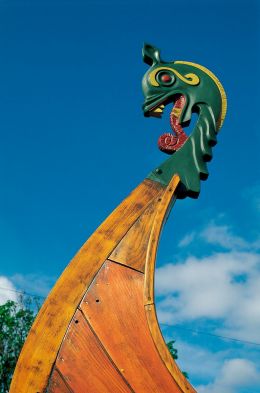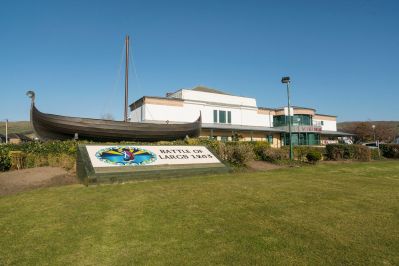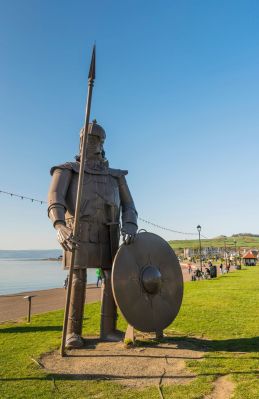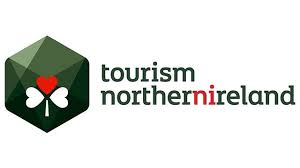Uncover the Viking roots of Britain and Ireland
For almost 300 years, from the first recorded invasion in 793 AD, life in Britain and Ireland was dictated by Viking conquest and settlement. Viking culture, as portrayed in countless movies and TV series, has left a permanent impact on the British Isles and this legacy can still be seen today. Uncover the Viking roots of Britain and Ireland on one of our tailor-made tours.
 Vikings in Scotland! © VisitScotland / Kenny Lam
Vikings in Scotland! © VisitScotland / Kenny Lam
You don’t have to look too hard to discover traces of Viking colonisation across Britain and Ireland. Many place names end in Old Norse suffixes, such as -by (meaning village) and -thorpe (meaning second dwelling); major streets often end in -gate (from gat meaning road) and cities such as York get their modern name from their Viking origins.
ENGLAND
The Viking raid on the island of Lindisfarne in Northumberland in 793 was significant in that it attacked the heart of a Christian settlement, sending shockwaves across the country and heralding the start of the Viking invasion of Britain, Ireland and many other parts of Europe.
 Lindisfarne Priory © English Heritage
Lindisfarne Priory © English Heritage
Lindisfarne Priory was one of the most important centres of Christianity in Anglo-Saxon England until the monks abandoned it after the Viking raid. Although today’s ruins date from the 12th century, it’s not difficult to imagine the impact the Viking invasion would have had. Lindisfarne is a remarkable place to visit - a place of quiet pilgrimage and turbulent history.
Don’t miss the Domesday Stone in Lindisfarne Priory Museum, which depicts a troop of uniformed warriors brandishing Viking-style battle-axes and swords on one side and, on the other, a symbolic Christian depiction of Doomsday.
 JORVIK ride experience © JORVIK Viking Centre
JORVIK ride experience © JORVIK Viking Centre
The city of York has one of the most important Viking histories in England and its name derives from Jorvik, meaning ‘wild boar creek’, the name of the original Viking settlement. Today, this Viking heritage is celebrated in the JORVIK Viking Centre. Travel back in time and take a ride through the Viking town – complete with sounds and smells – and explore state-of-the-art galleries showcasing a unique collection of Viking artefacts discovered in the city.
JORVIK Viking Festival is a city-wide celebration of York’s rich Norse heritage, which takes place each February. Enjoy Viking-themed processions, competitions, stalls, talks and more for all the family in Europe’s biggest Viking festival!
 Viking re-enactors at JORVIK © JORVIK Viking Centre
Viking re-enactors at JORVIK © JORVIK Viking Centre
Chester in north west England has a strong Viking history and visitors can take a guided walking tour which delves into the city’s Viking past, exploring how the Vikings lived and interacted with their Anglo-Saxon neighbours over 1,000 years ago.
 The historic city of Chester has a Viking past © VisitBritain / Lisa Ruohoniemi
The historic city of Chester has a Viking past © VisitBritain / Lisa Ruohoniemi
By the 9th century, London had become a prosperous trading centre and Norsemen periodically sailed up the River Thames in a series of attacks. The most famous of these was in 851 when around 350 longboats full of Vikings raided the city and burned it to the ground.
The British Museum and the Museum of London are the best places to learn about the Vikings’ lasting impact on London. The British Museum contains a vast collection of Viking artefacts, including the famous Lewis Chessmen (see below), a genuine Viking longboat and a Sutton Hoo helmet.
IRELAND
The Vikings invaded Dublin in 795 AD and ruled for over two hundred years. Today there are a number of sites in the city where the Vikings left their mark which can be seen on a tour of Viking Dublin.
Walk through time on a Viking Legacy Tour and learn about Dublin’s history from its beginnings as a small Gaelic settlement to the bustling Viking riverside town of Dubh Linn. The tours are led by guides in full Viking warrior battle costume!
 Viking longboat at Dublinia (photo courtesy of Dublinia)
Viking longboat at Dublinia (photo courtesy of Dublinia)
Dublinia Viking Museum, in the heart of Dublin where Viking settlements once stood, gives visitors the chance to find out about life in a Viking settlement. One of the city’s most popular family attractions, this living history museum allows visitors to see what life was like in Viking times - from a bustling Viking street scene, to life onboard a Viking longship.
Wood Quay, Dublin’s main Viking excavation site, came to global attention in 1974 when building works uncovered valuable insights into the city’s Viking past. Remains of Norse and Norman villages were unearthed alongside thousands of artefacts, many of which are on display in the National Museum of Ireland and Dublinia.
 Viking helmet at Dublinia (photo courtesy of Dublinia)
Viking helmet at Dublinia (photo courtesy of Dublinia)
The Steine of Long Stone, or Ivar the Boneless’s Pillar, is a replica of a carved pillar erected by the Vikings in the 10th or 11th century, which stands today at the junction of Pearse Street and College Street.
Sitric Silkenbeard, the Viking King of Dublin, built the original place of worship where Christ Church Cathedral now stands. A gift to the Irish church from the Vikings, pick up an audio guide when you visit to hear tales of the cathedral’s history from its Viking beginnings.
 Christ Church Cathedral © Fáilte Ireland, courtesy César Dive
Christ Church Cathedral © Fáilte Ireland, courtesy César Dive
At the Viking Ireland exhibition in the National Museum of Ireland, you can learn about the Viking Age in Ireland through many fascinating artefacts. It represents the finest collection in Europe of excavation finds from an early medieval urban centre.
In Waterford, Ireland’s oldest city, the Viking Triangle is the name given to the city’s cultural heritage area thanks to the Viking walls which once surrounded it. The best-known building in the Viking Triangle is Reginald’s Tower, the oldest urban civic building in Ireland, which houses the Viking Museum. A guided walking tour of the Viking Triangle is a must.
In Athlone, in Ireland’s Hidden Heartlands, you can step back 1,200 years and join the Vikings on a replica Viking Ship for a cruise on the River Shannon.
SCOTLAND
The Shetland Islands and the Orkney Islands off the north east coast of Scotland have long associations with the Vikings. Shetland and Orkney were colonised by the Vikings in the 8th and 9th centuries and remained under Norse control until the end of the 15th century.
 Jarlshof, Shetland © VisitScotland / Kenny Lam
Jarlshof, Shetland © VisitScotland / Kenny Lam
Containing remains dating from 2,500 BC up to the 17th century AD, Jarlshof in Shetland has been described as 'one of the most remarkable archaeological sites ever excavated in the British Isles'. The Viking Age ruins there are the largest in Britain and include a longhouse, the remains of which are clearly visible to this day. The visitor centre contains a collection of Viking artefacts.
Probably the most famous ‘Viking festival’ in the United Kingdom, Up Helly Aa, which takes place in Lerwick in Shetland on the last Tuesday of January each year, is actually just over 140 years old in its current form. However, the ingredients of the festival go back 12 centuries and more, with a torch-lit procession and the burning of a replica Viking ship. A memorable experience if you happen to be in northern Scotland in late January!
 Up Helly Aa, Shetland © VisitScotland / Luigi di Pasquale
Up Helly Aa, Shetland © VisitScotland / Luigi di Pasquale
The great story of Orkney’s Viking age is told in the Orkneyinga Saga, written in Iceland in the 12th century. Visitors can follow in the footsteps of the Vikings on the Orkneyinga Saga Trail, with interpretation boards marking key Viking events and places. The trail’s centre can be found in Orphir on Mainland in Orkney and the Orkneyinga Saga Centre there tells the story of the Norse Earls of Orkney.
The most iconic of Orkney’s Norse sites is St Magnus Cathedral in Kirkwall, a splendid medieval building which was at the heart of the powerful Earldom of Orkney. Discover the life and legacy of St Magnus on the 55-mile St Magnus Way walking route, which takes in many of Orkney’s Viking sites.
 A Viking figurehead in Orkney © VisitScotland / Paul Tomkins
A Viking figurehead in Orkney © VisitScotland / Paul Tomkins
The Isle of Lewis in the Outer Hebrides was the most densely populated Viking colony in the west of Scotland, and in 1831, 93 chessmen were found on a beach there. The Lewis Chessmen were skilfully carved out of walrus and whales’ teeth and have become one of the most famous images of the Viking Age. Today, 11 of the chessmen are at the National Museum of Scotland in Edinburgh, while the other 82 are at the British Museum in London.
In fact, the National Museum of Scotland is a great place to discover more about Viking Scotland, as it boasts a vast collection of Viking artefacts and weapons, including the Galloway Hoard, which consists of over 100 pieces of gold and silver - one of the most significant collections of Viking treasure ever found in Scotland.
 Vikingar! In Largs, Ayrshire © VisitScotland / Kenny Lam
Vikingar! In Largs, Ayrshire © VisitScotland / Kenny Lam
Largs in Ayrshire has an important Viking past as it was here that a decisive battle took place in 1263, ending nearly 500 years of Norse dominance in Scotland. The Largs Viking Festival is an annual event which marks the battle and sees a living history ‘Viking Village’ on Largs seafront.
Vikingar! in Largs is an award-winning, interactive experience where visitors can learn all about how the Vikings lived. Meet Viking storytellers who’ll welcome you into their replica of an eighth-century Norwegian Longhouse; try on replica armour and helmets, check out various weapons, and ‘interact’ with the Gods of Asgard!
And don’t miss the giant metal statue of Magnus the Viking on Largs seafront which was erected in 2013 to mark the 750th anniversary of the Battle of Largs.
 Magnus the Viking © VisitScotland / Kenny Lam
Magnus the Viking © VisitScotland / Kenny Lam
ISLE OF MAN
The Isle of Man, in the Irish Sea between Ireland, Scotland and England, was settled by the Vikings in the early ninth century and became a prosperous Viking colony, which benefited greatly from trade between Ireland and the Scottish islands.
 Peel Castle © visitisleofman
Peel Castle © visitisleofman
First constructed by the Vikings in the 11th century, Peel Castle is an important site of historical interest. In the early 1980s, archaeologists uncovered the grave of a high-status Viking woman who had been buried with a number of remarkable grave goods, including a necklace made of beads and a golden pin, which are now on display in the Viking Gallery at the Manx Museum. Peel Castle is a wonderfully atmospheric place to visit, with panoramic views of the Irish Sea.
In 800 AD the Vikings founded Tynwald, the oldest working parliament in the world, which is the Isle of Man parliament to this day. Tynwald means ‘open assembly’ in old Norse and can be linked to similar assemblies in Iceland and the Faroe Islands. Tynwald Hill at St John’s is the ancient meeting place of the assembly and is worth a visit. While the modern parliament meets in Douglas, the Isle of Man’s capital, once a year on Tynwald Day (5th July) an open-air ceremony is held at Tynwald Hill.
 Odin’s Raven at House of Mannan © visitisleofman
Odin’s Raven at House of Mannan © visitisleofman
For a taste of life in a Viking kingdom, visit the House of Mannan in Peel. This interactive museum takes visitors on a journey through the Isle of Man’s Celtic and Viking past, with a reconstruction of a Viking settlement and a replica of a famous Nordic ship known as Odin’s Raven.
If you or your group would like to uncover the Viking roots of Britain and Ireland on a tailor-made tour, please do contact our friendly team today and we will put together the perfect itinerary!































